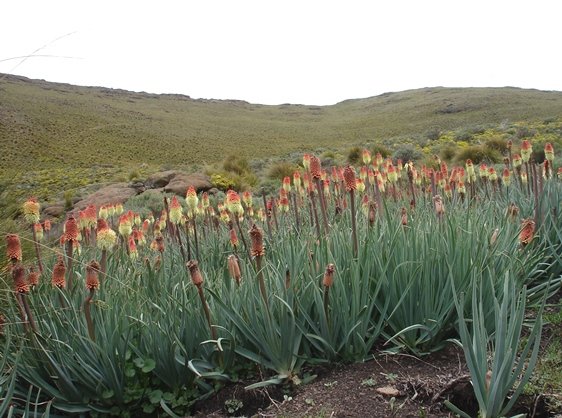Kniphofia caulescens biodiverse segregation

Author: Ivan Lätti
Photographer: Judd Kirkel Welwitch
The permutations and combinations of how life configures itself across space and time never cease to surprise. Habitat diversity can be warped into an in-your-face weird version of its intriguing and complex nature. This Kniphofia caulescens stand in the Drakensberg is an example.
A preference for particular soil, seasonal moisture availability and microclimatic conditions is suggested by the dense colony of plants seeking the company of its own kind on an “island” in a sea of everything. Underlying ecological resilience speaks quietly through details of the scene. Summer convection storms over the high-altitude grassland, followed by snowy winter and wind exposure sound like the imaginative tortures of a master sadist.
Plant responses? They steadily follow set seasonal cycles, although the incapable ones are dead and gone, leaving no clutter in the story. Intimately and inevitably juxtaposed leads to mutual impacting among survival partners while still all doing their own thing. Arm’s length is soon tightly together, weather permitting, making microhabitat clustering part of the lifestyle.
Robust stems and keel reinforcements on the narrow Kniphofia leaves say something about coping in snow and grass fire. Particular forms last better in the challenges of a given location. The currently living forms give the answer for here and now. But are the circumstances stable and durable? Does anybody ever know? The support system, the seasonal influx of companions run smoothly until it doesn’t. Then something must give. New adaptations are made by the survivors. The last word about life won’t be written by the dead.
And how to produce seed in a place like this? The Kniphofia’s sunbird pollinators arrive timeously in this unlikely place, a rewarded requirement and unspoken demand of long standing. The tight fit of mutual beneficiation between bird and flower is but one of the arrangements making life work for all participants in their zone where comfort fails as a descriptor.
Drakensberg grassland existence has shaped the reality of its residents for them to end up looking like this. For now. They will eventually change again if need be. Need will surely be but who keeps watch? Come check it out in the next millennium!
Or dictate different geographic, climatic and soil parameters. Add ages to taste for “cooking the stew” and Voila! Other, also weird species will be on show (Wikipedia).

